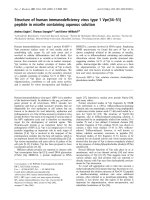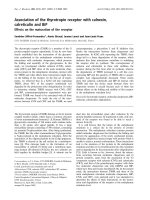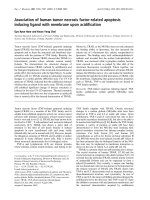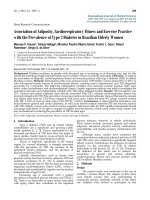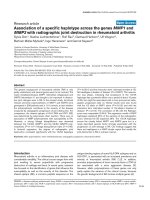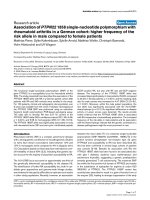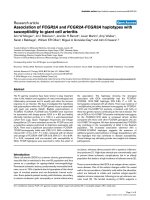Báo cáo Y học: Association of human tumor necrosis factor-related apoptosis inducing ligand with membrane upon acidification pdf
Bạn đang xem bản rút gọn của tài liệu. Xem và tải ngay bản đầy đủ của tài liệu tại đây (354.94 KB, 8 trang )
Association of human tumor necrosis factor-related apoptosis
inducing ligand with membrane upon acidification
Gyu Hyun Nam and Kwan Yong Choi
National Research Laboratory of Protein Folding and Engineering, Division of Molecular and Life Sciences, Pohang University of
Science and Technology, Pohang, Republic of Korea
Tumor necrosis factor (TNF)-related apoptosis inducing
ligand (TRAIL) has been known to induce tumor-specific
apoptosis and to share the structural and functional char-
acteristics with the proteins of TNF family. Recently, the
crystal structure of human TRAIL showed that TRAIL is a
homotrimeric protein whose subunits contain mainly
b-sheets. We characterized the structural changes of
recombinant human TRAIL induced by acidification and
the biological implication of the structural characteristics at
acidic pH in the interaction with the lipid bilayer. At acidic
pH below pH 4.5, TRAIL resulted in substantial structural
changes to a molten globule (MG)-like state. Far-UV CD
spectrum of TRAIL indicated that the acidification induced
a-helices that are absent in the native state. TRAIL at acidic
pH exhibited significant change of tertiary structures as
reflected in the near-UV CD spectrum. Thermal transition
curve indicated that there was less cooperation at acidic pH
than at neutral pH in the thermal denaturation of TRAIL.
Moreover, TRAIL at the MG-like state not only enhanced
the binding ability to liposomes, but also increased the
release rate of a fluorescent dye, calcein, encapsulated in
liposomes. The binding assay with anilinonaphthalene-8-
sulfonic acid revealed that the surface hydrophobicity of
TRAIL was increased while tryptophan residues became
more exposed to solvent as judged by blue shift of the
maximum fluorescence wavelength. Taken together, our
results demonstrate that the acidification of human TRAIL
induces the MG-like state in vitro and makes the membrane
permeable through the favorable interaction of TRAIL with
the membrane, implicating that general intrinsic properties
such as TRAIL, TNF-a and lymphotoxin are shared by
TNF family members.
Keywords: TNF-related apoptosis inducing ligand; TNF
family; acidification; molten globule (MG)-like state;
a-helices.
Tumor necrosis factor (TNF)-related apoptosis inducing
ligand (TRAIL) is a member of the TNF family and its
soluble form exhibited apoptotic activity for various cancer
cell lines with minimal cytotoxicity toward normal tissues
both in vitro and in vivo [1–5]. TRAIL has been known to be
involved in CD4
+
T cell-mediated and monocyte-induced
cytotoxicity [6,7]. TRAIL has drawn a great deal of
attention in the field of cell death because it induces
apoptosis in most transformed cells and some virally
infected cells, but not in normal cells [1,2]. However, despite
the ubiquitous existence of TRAIL and its ability to induce
apoptosis in many different tumor cells, little is known
about structural characteristics for its biological action.
TNF-a and lymphotoxin (LT) are trimeric proteins
whose subunits contain mainly b-sheets, and belong to the
TNF family together with TRAIL. Drastic structural
changes to a molten globule (MG)-like state have been
observedinTNF-a and LT at acidic pH values. Upon
acidification, TNF-a and LT were found not only to have
non-native secondary structures [8,9], but also to be able to
be inserted into lipid bilayers [9,10]. Besides the TNF family
proteins, a variety of proteins at acidic pH have been
demonstrated to form the MG-like state retaining their
partial secondary structures but lacking complete tertiary
structures. For both bovine [11] and human [12]
a-lactalbumin, as well as for bovine carbonic anhydrase B
[13], MG-like states also were induced at acidic pH values. It
has been proposed that the biological function of the MG-
like state may be implicated in membrane interaction as
shown in the case of colicin A at acidic pH [14–16].
TRAIL is a protein which can self-associate into a trimer.
The crystal structure of human TRAIL [17,18] and the
crystal structure in complexes with death receptor-5 [19–21]
revealed that the individual TRAIL subunit mostly consists
of antiparallel b-sheets and can be organized to form a
jellyroll b-sandwich. Very recently, a unique zinc binding
site was found and a zinc ion was known to be important for
the trimeric structure of TRAIL [18]. TRAIL shares with
TNF-a and LT characteristics such as sequence homology,
three-dimensional structure, and cytotoxicity. In case of
TNF-a and LT, the tumor cell killing activities enhanced by
acidification led to the discovery that TNF-a and LT share
the abilities to associate with and penetrate membranes, and
the structural characteristics acquired by acidification
Correspondence to K. Y. Choi, National Research Laboratory of
Protein Folding and Engineering, Division of Molecular and Life
Sciences, Pohang University of Science and Technology,
Pohang, 790–784, Republic of Korea.
Fax: + 82 54 2792199, Tel.: +82 54 2792295,
E-mail:
Abbreviations: ANS, 1-anilinonaphthalene-8-sulfonic acid; Myr
2
Gro-
PCho, dimyristoylglycerophosphocholine; LT, lymphotoxin; MG,
molten globule; PtdSer, phosphatidylserine; TNF, tumor necrosis
factor; TRAIL, TNF-related apoptosis inducing ligand.
(Received 6 June 2002, revised 6 August 2002,
accepted 9 September 2002)
Eur. J. Biochem. 269, 5280–5287 (2002) Ó FEBS 2002 doi:10.1046/j.1432-1033.2002.03242.x
provided a reasonable explanation for the acid-enhanced
membrane interactions [9,10,22–24]. While TRAIL has
been investigated mainly on the molecular mechanism for
receptor-mediated apoptosis, few studies have been carried
out with TRAIL concerning the structure–function rela-
tionship under environments such as acidic pH values.
Thus, it would be interesting to compare the structural
features of TRAIL with those of two well-characterized
TNF family proteins, TNF-a and LT, in their association
with membranes upon acidification.
In this study, acidification of TRAIL resulted in the
drastic structural changes to an MG-like state where the
secondary structure was significantly changed and non-
native a-helices were induced. In its MG-like state, TRAIL
could make membranes permeable by enhancing its
liposome binding ability. Our results demonstrate that the
structural changes of TRAIL are responsible for the
increased membrane permeability which is mediated by
enhanced membrane binding under acidic environments,
implicating that the general intrinsic properties are shared
by TNF family members.
EXPERIMENTAL PROCEDURES
Preparation of recombinant human TRAIL
The truncated recombinant TRAIL containing amino acids
114–281, referred to from now on as TRAIL, coding for the
extracellular region of the full-length human TRAIL, was
produced and purified as described previously [25]. The
TRAIL gene, inserted into downstream of the T7 promoter
in a plasmid vector, pET-3a [26], was introduced into
Escherichia coli strain BL21(DE3). Bacterial cells were
grown while the expression of TRAIL was induced with
1m
M
isopropyl-
D
-thiogalactoside at 37 °C for 4 h. The
bacterial cells were harvested and resuspended in a buffer
solution containing 20 m
M
sodium phosphate, pH 7.0,
100 m
M
NaCl, and 1 m
M
dithiothreitol. After sonication,
soluble fractions were obtained by centrifugation and
applied onto an SP Sepharose Fast Flow column (Amer-
sham Pharmacia Biotech). The bound fraction was concen-
trated by use of Centri-prep (Amicon) and then loaded onto
Superdex 200 HR 10/30 column (Amersham Pharmacia
Biotech) for gel-filtration chromatography. The purified
TRAIL appeared as a single band on SDS/PAGE analysis
(data not shown).
CD spectroscopy
CD spectroscopic analyses were performed with a spectro-
polarimeter (Jasco, 715). A cuvette with a path length of
2 mm for far-UV region (200–250 nm) or a path length of
5 mm for near-UV region (250–300 nm) was used for the
CD spectral measurements. The temperature of the cuvettes
was adjusted to 25 °C by use of a Peltier type temperature
controller (Jasco, PTC-348WI). The protein concentration
was 10 l
M
for far-UV CD measurements and 50 l
M
for
near-UV CD measurements, respectively. TRAIL was
dissolved in a buffer containing 100 m
M
NaCl and 1 m
M
dithiothreitol with either 20 m
M
sodium phosphate, pH 7.0
or 20 m
M
sodium acetate, pH 4.5. CD spectra were
obtained with a scanning speed of 10 nmÆmin
)1
and a
bandwidth of 2 nm. Scans were collected at 1-nm intervals
with a response time of 0.25 s and were accumulated three
times. Each spectrum was corrected by subtracting the
spectrum of the buffer at the respective pH. Thermal
denaturation was monitored by measuring molar ellipticity
at 222 nm in the same spectropolarimeter upon the
temperature change with the heating rate of 30 °CÆh
)1
.
Fluorescence measurements
Fluorescence spectra were obtained by use of a spectroflu-
orimeter (Shimadzu, RF-5401) equipped with a thermo-
statically controlled cell holder. TRAIL samples (each
10 l
M
) at neutral and acidic pH values were prepared,
respectively, with the same buffers as those in the CD
spectroscopic measurements. To obtain TRAIL in its
unfolded state, it was dissolved in 6
M
guanidine hydro-
chloride. Fluorescence spectra of TRAIL were obtained
between 300 and 400 nm at 25 °C with the excitation
wavelength at 295 nm. Each spectrum represented the
average of three sequential scans with the spectrum of the
buffer being subtracted.
ANS binding assay
Binding experiment with anilinonaphthalene-8-sulfonic acid
(ANS; Molecular Probes) was performed by incubating
TRAIL with ANS at acidic or neutral pH. The final
concentrations of TRAIL and ANS were both 10 l
M
.The
mixture of TRAIL and ANS was incubated at either pH 7.0
or 4.5 for 15 min. The incubated solution was then excited
at 380 nm and the fluorescence changes were subsequently
monitored between 400 nm and 600 nm at 25 °C. Fluores-
cence spectra were obtained by a spectrofluorimeter (Shim-
adzu, RF-5401) using a cuvette with a path length of
10 mm, and subtracted from the spectrum of the ANS
solution without TRAIL.
Liposome preparation
Dimyristoylglycerolphosphocholine (Myr
2
Gro-PCho; Sig-
ma) and bovine brain phosphatidylserine (PtdSer; Sigma)
were dried in a glass test tube with a stream of nitrogen.
Large unilamellar vesicles of about 1000-A
˚
diameter were
prepared according to the reverse-phase evaporation
method as described previously [23]. Briefly, they were
prepared in a buffer containing 20 m
M
sodium phosphate,
pH 7.0, 100 m
M
NaCl and 1 m
M
dithiothreitol. The
liposomes were extruded through a polycarbonate mem-
brane (Nucleopore, Pleasanton, CA, USA) of 0.1 lm pore
diameter and then diluted into the respective buffer; a buffer
containing 20 m
M
sodium phosphate, 100 m
M
NaCl, and
1m
M
dithiothreitol for pH 7.0 or pH 6.0; and a buffer
containing 20 m
M
sodium acetate, 100 m
M
NaCl, and
1m
M
dithiothreitol for pH 5.0 or 4.5. Phospholipid
concentration was determined according to the phosphorus
assay method as described previously [27].
Liposome binding assay
The amount of liposome-bound TRAIL was determined as
follows: TRAIL at 10 lgÆmL
)1
was incubated at 25 °Cfor
30 min with or without liposomes containing 100 l
M
phospholipid in the respective buffer solution at pH 7.0,
Ó FEBS 2002 Association of human TRAIL with membrane at acidic pH (Eur. J. Biochem. 269) 5281
6.0, 5.0 and 4.5, respectively, as described in the liposome
preparation. The mixture was then centrifuged at 13 000 g
for 5 min and subjected to 15% SDS/PAGE. Densitometric
scanning of the protein bands on the gel was performed to
quantify the liposome-bound TRAIL.
Leakage assay
Liposomes at pH 7.0, 6.0, 5.0 and 4.5 were prepared as
described in the liposome preparation except the buffer
containing calcein (Sigma), a fluorescent dye. Liposomes at
the respective pH were prepared in the buffer containing
1m
M
calcein. The liposome suspension was sonicated and
then applied onto a Sephadex G-50 column (Amersham
Pharmacia Biotech) to separate free calcein from liposome-
entrapped calcein. The reaction was initiated by adding
various amounts of TRAIL to the liposome suspension
containing 1 m
M
of calcein and 50 l
M
of phospholipid in the
buffer of the respective pH at 25 °C. The reaction was
stopped 2 min after the initiation. The leakage rate of calcein
in the liposomes was determined by monitoring the fluores-
cence spectraof calcein.Excitation andemission wavelengths
were 470 and 520 nm, respectively. Triton X-100 was added
to release calcein encapsulated in liposomes and then the
fluorescence intensity of calcein was determined to assess the
amount of calcein in the liposome.
RESULTS
Structural analyses of TRAIL by CD spectroscopy
The effects of acidification on the contents of secondary
structures in TRAIL were estimated by CD spectroscopy.
The far-UV CD spectra of TRAIL at pH 7.0 and at pH 4.5
are shown in Fig. 1A. At pH 7.0, the spectrum of TRAIL
exhibited a typical pattern reflecting the high content of
b-sheet structures with a single negative maximum ellipticity
around 218 nm as observed for TNF family proteins. The
negative ellipticities from 200 to 220 nm were increased
significantly upon lowering pH to below 4.0. To estimate the
spectral transition in the far-UV region by CD spectroscopy
upon the pH change, the spectra were monitored at pH 5.0,
4.5 and 4.0, respectively. The distinct spectral change was
observed below pH 4.5. The negative ellipticity at 222 nm
was increased from about )2200 °Æcm
)2
Ædmol
)1
at pH 7.0 to
)3200 at pH 4.5 (Fig. 1A). This spectral change strongly
indicates that a-helical structure was induced upon acidifi-
cation. The near-UV CD spectrum of TRAIL at pH 7.0
exhibited strongly negative ellipticities at 275 and 285 nm.
These signals were drastically weakened in an acidic
environment (Fig. 1B). Thus, at pH 4.5 TRAIL possesses
a structure different from that in its native state and with a
significant change of tertiary structure. Meanwhile, the
effect of zinc ions on the conformation of TRAIL at acidic
pH was investigated by analyzing the CD spectra of
TRAIL, as zinc ions were recently found to be important to
the structure of TRAIL [18]. The far- and near-UV CD
spectra of TRAIL at pH 4.5 were not significantly altered in
metal-free solution (data not shown).
Thermal denaturation at neutral and acidic pH values
To investigate the effect of pH on the cooperation of
TRAIL for unfolding, the thermal denaturation was
monitored by measuring the changes in molar ellipticity at
222 nm at various temperatures. No significant changes in
the CD ellipticity were observed at neutral pH values up to
46 °C (Fig. 2). In the range of 68–79 °C, however, a drastic
transition in sigmoidal transition curve of the ellipticity was
observed, with a transition midpoint at 74 °C, indicating
that the thermal transition at neutral pH is cooperative. On
the other hand, the negative ellipticity at pH 4.5 was
gradually increased upon raising temperature, and the
thermal transition was not cooperative and occurred over a
much wider temperature range than at neutral pH.
Fluorescence spectroscopy
Fluorescence spectra were obtained to analyze the effect of
pH on the structure of TRAIL. The fluorescence spectrum
Fig. 1. CD spectra of TRAIL at pH 7.0 (solid line) and pH 4.5 (dashed line). (A) Far-UV and (B) near-UV CD spectra of TRAIL at pH 7.0
and 4.5, respectively, are shown. The protein concentrations were 10 l
M
for the far-UV CD measurements and 50 l
M
for the near-UV CD
measurements. TRAIL was dissolved in either 20 m
M
sodium phosphate, pH 7.0, or 20 m
M
sodium acetate, pH 4.5, containing 100 m
M
NaCl and
1m
M
dithiothreitol, respectively. All the CD spectra were obtained after the incubation of the protein with the buffer at the respective pH.
5282 G. H. Nam and K. Y. Choi (Eur. J. Biochem. 269) Ó FEBS 2002
of TRAIL at acidic pH lies between that of the native state
and of the unfolded state. As shown in Fig. 3, the maximum
fluorescence wavelength (k
max
) of TRAIL at pH 7.0 was
330 nm and shifted to 350 nm at unfolded state. The k
max
of
TRAIL was shifted to 337 nm at pH 4.5 and its fluores-
cence intensity was decreased by about 40% relative to that
at pH 7.0. These results reveal that aromatic residues such
as tryptophan might be partially exposed to an aqueous
environment at acidic pH values [16]. When the pH was
returned to 7.0, the k
max
was decreased reversibly to
330 nm.
Interaction with ANS
To compare the relative hydrophobic surface area of
TRAIL between the native and acidic states, binding
experiments with ANS were performed. ANS, a fluorescent
probe, has been utilized to monitor conformational changes
of the protein with the subsequent exposure of hydrophobic
binding sites on proteins, as described previously [28,29].
Fluorescence spectra and quantum yield of ANS were
shown to be sensitive to the environment around the probe
[29]. Changes of the pH between 7.0 and 4.5 in the absence
of TRAIL had no effect on the ANS spectrum, and ANS
alone did not display any significant fluorescence intensity
between 400 and 600 nm (data not shown). Compared with
the free dye in the solution, TRAIL resulted in a drastic
increase in the fluorescence intensity upon binding ANS.
ANS was bound to TRAIL at acidic pH values more
favorably than at neutral pH (Fig. 4). When ANS was
bound to TRAIL at pH 7.0, the ANS fluorescence was
marginally enhanced, suggesting that TRAIL at neutral pH
can bind ANS weakly. When the pH was lowered to 4.5, the
fluorescence intensity was increased dramatically (by about
2.5-fold), and the k
max
of TRAIL was blue-shifted from
514 nm to 487 nm. These spectral changes imply that, at
acidic pH, TRAIL might contain hydrophobic sites which
bind ANS more strongly than at neutral pH. Shifting the
pH from 4.5 back to 7.0 resulted in resumption of the
original spectrum at pH 7.0, indicating that the exposure of
hydrophobic binding sites of TRAIL seemed to be revers-
ible (data not shown).
Fig. 3. Fluorescence spectra of TRAIL at pH 7.0 (solid line), pH 4.5
(dashed line), and unfolded state (dotted line), respectively. The protein
samples at pH 7.0 and pH 4.5 were prepared, respectively, in the same
buffers used for the CD measurements. The sample of TRAIL in its
unfolded state was prepared in 6
M
guanidine hydrochloride. The
protein samples at 10 l
M
concentration were excited at 295 nm and
the emission spectra were observed at between 300 and 400 nm.
Fig. 4. Interaction of ANS either without (dotted line) or with TRAIL at
pH 7.0 (solid line) and pH 4.5 (dashed line). The protein samples at
10 l
M
wereincubatedwith10l
M
of ANS at the indicated pH values.
The protein samples were excited at 380 nm and fluorescence spectra
were obtained at between 400 and 600 nm.
Fig. 2. Thermal transition curves for the molar ellipticity of TRAIL at
pH 7.0 (solid line) and pH 4.5 (dashed line). Cooperation of TRAIL for
thermal denaturation was observed at pH 7.0 when the CD signal at
222 nm was monitored with increasing temperature. The concentra-
tion of TRAIL was 10 l
M
and the heating rate was 30 °CÆh
)1
.The
protein samples were prepared in a buffer containing 100 m
M
NaCl
and 1 m
M
dithiothreitol with either 20 m
M
sodium phosphate, pH 7.0,
or 20 m
M
sodium acetate, pH 4.5.
Ó FEBS 2002 Association of human TRAIL with membrane at acidic pH (Eur. J. Biochem. 269) 5283
Binding of TRAIL to liposome membrane
To assess the extent of binding capability of TRAIL with
lipid bilayer at various pH values, TRAIL was incubated at
pH 7.0, 6.0, 5.0 and 4.5, respectively, with liposomes which
had been prepared from the mixtures of Myr
2
Gro-PCho
and PtdSer. The protein samples alone were not precipitated
at the respective pH upon centrifugation, as judged by SDS/
PAGE analysis. The amount of TRAIL bound to liposomes
was observed to decrease with increasing pH (Fig. 5). Only
a marginal amount of TRAIL was bound to Myr
2
Gro-
PCho/PtdSer vesicles at pH values above 5.0. The amount
of TRAIL bound to liposomes was below 10% of the total
TRAIL added at pH 5.0–7.0, whereas it was increased up to
about 35% at pH 4.5, indicating that TRAIL can be bound
to lipid vesicles more favorably at acidic pH than at neutral
pH.
Release of liposome-entrapped dye induced by TRAIL
As estimated by SDS/PAGE, TRAIL was bound more
favorably to lipid vesicles consisting of Myr
2
Gro-PCho and
PtdSer at acidic pH values. In many cases, the binding of a
protein with lipid bilayer disrupts the bilayer integrity to
make the membranes permeable [30,31]. To ascertain
whether TRAIL alters the permeability of the membrane,
the release of a fluorescent dye, calcein, entrapped in the
liposome consisting of Myr
2
Gro-PCho and PtdSer (1 : 1
molar ratio) was monitored in the presence of TRAIL at
various pH values. Myr
2
Gro-PCho/PtdSer vesicles alone
were not leaky at pH 4.5–7.0. Figure 6 shows the pH
dependence of the release rate of calcein induced by TRAIL.
Upon adding TRAIL, marginal release of calcein from
liposomes was observed above pH 6.0, but the permeability
was changed below pH 6.0. Particularly, the release rate of
the dye was increased drastically upon lowering pH below
5.0. Therefore, our results indicate that TRAIL could
induce the release of calcein from liposomes through the
interaction with lipid vesicles. Figure 7 shows the depend-
Fig. 5. pH dependence of binding of TRAIL to liposome. TRAIL at
10 lgÆmL
)1
was incubated at 25 °C with liposomes consisting of
Myr
2
Gro-PCho and PtdSer (1 : 1 molar ratio, 100 l
M
phospholipid)
at various pH valuess (lane 1, pH 7.0; lane 2, pH 6.0; lane 3, pH 5.0;
lane 4, pH 4.5). After 30 min, the liposome-bound TRAIL was sep-
arated from liposome-free TRAIL by use of a Sephadex G-50 column.
The amount of liposome-bound TRAIL was determined by scanning
the protein bands on the SDS/PAGE gel. Lane 5 represents TRAIL
standard (5 lg).
Fig. 6. pH dependence of the release rate of calcein from liposomes
induced by TRAIL. TRAIL at 1 lgÆmL
)1
was added to liposome
suspensions consisting of Myr
2
Gro-PCho and PtdSer (1 : 1 molar
ratio, 50 l
M
phospholipid) containing calcein at pH 7.0, 6.0, 5.0 and
4.5. Increase of calcein fluorescence was monitored at 25 °Cwith
excitation and emission wavelengths of 470 and 520 nm, respectively.
The fluorescence intensity of calcein after adding Triton X-100 devoid
of TRAIL was taken as 100%. Three independent measurements were
performed and the error bars represent one standard deviation of the
measurements.
Fig. 7. Dependence of the release rate of calcein from liposomes on the
amountofTRAILatpH4.5.Various amounts of TRAIL were added
to liposomes consisting of Myr
2
Gro-PCho and PtdSer (1 : 1 molar
ratio, 50 l
M
phospholipid) containing calcein at pH 4.5. The release
rate was determined by monitoring the increase in the fluorescence
intensity of calcein released from liposomes with excitation and emis-
sion wavelengths of 470 and 520 nm, respectively, at 25 °C while the
amount of TRAIL is increased. Three independent measurements were
performed and the error bars represent one standard deviation of the
measurements.
5284 G. H. Nam and K. Y. Choi (Eur. J. Biochem. 269) Ó FEBS 2002
ence of the release rate on the amount of TRAIL at pH 4.5.
The leakage rate was proportional to the amount of
TRAIL, indicating that the observed release from liposomes
could be induced by TRAIL.
DISCUSSION
Acidification induced dramatic structural changes in
TRAIL. The structural changes of TRAIL at acidic pH
resulted in an MG-like state which retained a substantial
secondary structure but lost a rigid tertiary structure.
TRAIL at acidic pH was observed to contain not only
increased hydrophobic surface but also a non-native
a-helical structure. Moreover, TRAIL was found to be
able to bind to the lipid membrane in such a way as to make
the membrane permeable when pH was lowered. Thus, the
structural changes of TRAIL by acidification provide an
explanation for intrinsic properties of TRAIL toward the
membrane, as observed in such structurally and evolutio-
narily related cytokines as TNF-a and LT.
TRAIL in its native state consists mostly of b-sheets.
When it was partially unfolded by acidification, it induced
an MG-like state with a substantial change in the secondary
structure. One of the important features of TRAIL in its
MG-like state is that it contains the non-native a-helices
upon acidification. A similar observation was made for
TNF-a, another member of the TNF family [8,32]. The far-
UV CD spectrum of TRAIL at acidic pH is very similar to
that in the acid-unfolded TNF-a, suggesting that the
content of the secondary structure at acidic pH should be
similar to and the induction of non-native a-helices seems to
be shared by two proteins that belong to the TNF family.
The induction of a-helices has been known to mediate the
insertion of proteins into membrane [9,24,33]. Thus, the
induction of a-helices might give a structural basis for
membrane interaction properties of TRAIL upon acidifi-
cation.
Besides similar features of MG-like states between TNF-a
and TRAIL, TNF family proteins also have a high sequence
homology and their crystal structures consist of jellyroll
b-sheets with close similarities [17,34,35]. In particular, the
number and location of tryptophan residues are conserved
precisely among TRAIL, TNF-a and LT in all species
analyzed. There are two tryptophans per monomer. The
red shift of k
max
as well as the decrease of tryptophan
fluorescence intensity occurring when TRAIL was acidified
indicates that environments surrounding the tryptophan
residues of TRAIL at acidic pH values become more polar
relative to those at neutral pH; such spectral changes were
also observed with two other TNF family proteins, TNF-a
and LT [8,9]. The structural changes that enable the
positional shift of tryptophan residues to the surface of
TRAIL are accompanied by the exposure of hydrophobic
binding sites for the dye ANS. The ANS fluorescence alone
was not affected over a wide range of pH. However, a
substantial increase of fluorescence intensity was observed
for TRAIL exposed to ANS at pH 4.5 compared with at
pH 7.0. These changes in fluorescence properties are
characteristic of ANS bound to proteins through hydro-
phobic interactions. The extent of ANS binding at acidic
pH is similar among TRAIL, TNF-a and LT [9,24],
suggesting that both exposure of hydrophobic surface to
bind ANS and the positional shift of the tryptophan residue
to an aqueous environment are common phenomena
among the three TNF family proteins.
In case of TNF-a and LT, the hydrophobic surface
exposed by acidification [9,24] and induction of non-native
a-helices [8] provides a possible explanation for the acid-
enhanced membrane-interaction properties of two
proteins. It would be also interesting to investigate
whether the structural changes of TRAIL at acidic pH,
as characterized in this study, can induce membrane
binding and subsequent membrane leakage. TRAIL could
lead to membrane leakage induced by intrinsic membrane
interaction using purified TRAIL and liposome systems.
Release rate of liposome-entrapped dye induced by
TRAIL as well as membrane binding ability of TRAIL
were found to be dependent on the pH of the local
environment. TRAIL exhibited increased membrane
binding with decreasing pH. Concomitantly, it induced
membrane leakage below pH 5.0, as the release rate of
calcein was significantly increased. Therefore, the present
results clearly show that TRAIL induced release of calcein
from liposomes consisting of Myr
2
Gro-PCho and PtdSer
when it was more tightly bound to them. Taken together,
our results suggest that the structural changes of TRAIL at
acidic pH might potentially be significant for interactions
with the membrane.
Even though receptor-mediated apoptosis for TRAIL
was extensively investigated, little information is available
for the regulation of the expression of TRAIL. TNF-a and
LT of the same TNF family to which TRAIL belongs were
found to be cleaved in vivo by metalloprotease and released
from the activated macrophage where the local environment
becomes acidic [36–38]. The soluble forms of TNF-a and
LT displayed dramatic structural changes at low pH, and
their membrane binding and channel forming activities were
remarkably enhanced at low pH [9,10,24]. In addition, the
biological cytotoxicity of TNF-a was increased at low pH
[10,24]. Recent studies showed that soluble TRAIL is
generated in vitro by cysteine proteases [39] and was released
from the monocytes and macrophages by lipopolysaccha-
ride stimulation [40], like TNF-a and LT. Alternatively,
when TRAIL is located in acidic environments such as
endocytic vesicles, endosomes or lysosomes by receptor-
mediated endocytosis, it might perturb or disrupt their
membrane structure similar to the case of TNF-a, whose
cytotoxicity seems to be related to receptor-mediated
endocytosis [41,42]. With these observations, structural
changes of TRAIL induced by acidification reveal that
TRAIL might have a potential acid-enhanced cytotoxicity
and its intrinsic property be also shared by those of TNF-a
and LT.
In conclusion, TRAIL shows striking similarities to
TNF-a and LT in terms of structural features and
membrane-interaction properties in acidic environments.
The acid-enhanced ability of TRAIL for membrane binding
which results in the membrane leakage is closely associated
with structural changes to the MG-like state which include
the induction of a-helices and the exposure of hydrophobic
binding sites, as judged by the movement of tryptophan
residues to an aqueous environment. Even if our studies are
not conceptually novel, they will contribute to the under-
standing of the intrinsic properties of TRAIL for inducing
membrane disruption under acidic environments, as
observed in other members of the TNF family. More
Ó FEBS 2002 Association of human TRAIL with membrane at acidic pH (Eur. J. Biochem. 269) 5285
detailed analyses on the biochemical characteristics of
TRAIL might give valuable information for in vivo function
of TRAIL.
ACKNOWLEDGMENTS
The recombinant TRAIL gene encoding amino acids 114–281 of the
full-length human TRAIL was kindly supplied by Professor Byung-Ha
Oh. We would like to thank Dr Sun-Shin Cha for his assistance in
TRAIL purification and Jung Hwan Kim for his technical help in
liposome preparation.
This research was supported by grants from the programs of
National Research Laboratory sponsored by Korean Ministry of
Science and Technology and G. H. N. was supported in part by the
Brain Korea 21 project.
REFERENCES
1. Wiley, S.R., Schooley, K., Smolak, P.J., Din, W.S., Huang, C.P.,
Nicholl, J.K., Sutherland, G.R., Smith, T.D., Rauch, C., Smith,
C.A. et al. (1995) Identification and characterization of a new
member of the TNF family that induces apoptosis. Immunity 3,
673–682.
2. Pitti, R.M., Marster, S.A., Ruppert, S., Donahue, C.J., Moore, A.
& Ashkenazi, A. (1996) Induction of apoptosis by Apo-2 ligand, a
new member of the tumor necrosis factor cytokine family. J. Biol.
Chem. 271, 12687–12690.
3. Griffith, T.S., Chin, W.A., Jackson, G.C., Lynch, D.H. & Kubin,
M.Z. (1998) Intracellular regulation of TRAIL-induced apoptosis
in human melanoma cells. J. Immunol. 161, 2833–2840.
4. Schneider,P.,Holler,N.&Bodmer,J.L.,Hahne,M.,Frei,K.,
Fontana, A. & Tschopp, J. (1998) Conversion of membrane-
bound Fas (CD95) ligand to its soluble form is associated with
downregulation of its proapoptotic activity and loss of liver toxi-
city. J. Exp. Med. 187, 1205–1213.
5. Walczak, H., Miller, R.E., Arial, K., Gliniak, B., Griffith, T.S.,
Kubin, M., Chin, W., Jones, J., Woodward, A., Le, T., Smith, C.,
Smolak, P., Goodwin, R.G., Rauch, C.J., Schub, J.C. & Lynch,
D.H. (1999) Tumoricidal activity of tumor necrosis factor-related
apoptosis-inducing ligand in vivo. Nat. Med. 5, 157–163.
6. Griffith, T.S., Wiley, S.R., Kubin, M.Z., Sedger, L.M., Malis-
zewski,C.R.&Fanger,N.A.(1999)Monocyte-mediatedtumor-
icidal activity via the tumor necrosis factor-related cytokine,
TRAIL. J. Exp. Med. 189, 1343–1354.
7. Kayagaki, N., Yamaguchi, N., Nakayama, M., Kawasaki, A.,
Akiba,H.,Okuma,K.&Yagita,H.(1999)Involvementof
TNF-related apoptosis-inducing ligand in human CD4+
T cell-mediated cytotoxicity. J. Immunol. 162, 2639–2647.
8. Hlodan, R. & Pain, R.H. (1994) Tumor necrosis factor is in
equilibrium with a trimeric molten globule at low pH. FEBS Lett.
343, 256–260.
9. Baldwin, R.L., Mirzabekov, T., Kagan, B.L. & Wisnieski, B.J.
(1995) Conformation and ion channel activity of lymphotoxin at
neutral and low pH. J. Immunol. 154, 790–798.
10. Baldwin, R.L., Chang, M.P., Bramhall, J., Graves, S., Bonavida,
B. & Wisnieski, B.J. (1988) Capacity of tumor necrosis factor to
bind and penetrate membranes is pH-dependent. J. Immunol. 141,
2352–2357.
11. Kuwajima, K., Nitta, K., Yoneyama, M. & Sugai, S. (1976)
Three-state denaturation of alpha-lactalbumin by guanidine
hydrochloride. J. Mol. Biol. 106, 359–373.
12. Nozaka, M., Kuwajima, K., Nitta, K. & Sugai, S. (1978) Detec-
tion and characterization of the intermediate on the folding
pathway of human alpha-lactalbumin. Biochemistry 17, 3753–
3758.
13. Wong, K P. & Hamlin, L.M. (1974) Acid denaturation of bovine
carbonic anhydrase B. Biochemistry 13, 2678–2683.
14.Pattus,F.,Carvard,D.,Crozel,V.,Baty,D.,Adrian,M.&
Lazdunski, C. (1985) pH-dependent membrane fusion is pro-
moted by various colicins. EMBO J. 4, 2469–2474.
15. Frenette, M., Khibiehler, M., Baty, D., Geli, V., Pattus, F.,
Verger, R. & Lazdunski, C. (1989) Interaction of colicin A with
phospholipid monolayers and liposomes: relevance to the
mechanism of action. Biochemistry 28, 2509–2514.
16. van der Goot, F.G., Gonzalez-Manas, J.M., Lakey, J.H. & Pattus,
F. (1991) A Ômolten-globuleÕ membrane-insertion intermediate of
the pore-forming domain of colicin A. Nature 354, 408–410.
17. Cha, S S., Kim, M S., Choi, Y.H., Sung, B.J., Shin, N.G., Shin,
H C., Sung, Y.C. & Oh, B H. (1999a) 2.8 A
˚
resolution crystal
structure of human TRAIL, a cytokine with selective antitumor
activity. Immunity 11, 253–261.
18. Hymowitz, S.G., O’Connell, M.P., Ultsch, M.H., Hurst, A., Tot-
pal, K., Ashkenazi, A., de Vos, A.M. & Kelley, R.F. (2000) A
unique zinc-binding site revealed by a high resolution X-ray
structure of homotrimeric Apo2L/TRAIL. Biochemistry 39,633–
640.
19. Hymowitz, S.G., Christinger, H.W., Fuh, G., Ultsch, M.H.,
O’Connell, M.P., Kelley, R.F., Ashkenazi, A. & de Vos,
A.M. (1999b) Triggering cell death: the crystal structure of
Apo2L/TRAIL in a complex with death receptor 5. Mol. Cell 4,
563–571.
20. Mongkolsapaya, J., Grimes, J.M., Chen, N., Xu, X N., Stuart,
D.I.,Jones,E.Y.&Screaton,G.R.(1999)Structureofthe
TRAIL-DR5 complex reveals mechanisms conferring specificity
in apoptotic initiation. Nat. Struct. Biol. 6, 1048–1053.
21. Cha, S S., Sung, B., J., Kim, Y A., Song, Y L., Kim, H J., Kim.
S., Lee, M S. & Oh, B H. (2000) Crystal structure of
TRAIL-DR5 complex identify a critical role of the unique frame
insertion in conferring recognition specificity. J. Biol. Chem. 275,
31171–31177.
22. Oku,N.,Araki,R.,Araki,H.,Shibamoto,S.,Ito,F.,Nishihara,
T. & Tsujimoto, M. (1987) Tumor necrosis factor-induced
permeability increase of negatively charged phospholipid vesicles.
J. Biochem. 102, 1303–1310.
23. Yoshimura, T. & Sone, S. (1987) Different and synergistic actions
of human tumor necrosis factor and interferon-c in damage of
liposome membranes. J. Biol. Chem. 262, 4597–4601.
24. Baldwin, R.L., Stolowitz, M.L., Hood, L. & Wisnieski, B.J. (1996)
Structural changes of tumor necrosis factor a associated with
membrane insertion and channel formation. Proc. Natl Acad. Sci.
USA 93, 1021–1026.
25. Cha, S S., Shin, H C., Choi, K.Y. & Oh, B H. (1999b) Expres-
sion, purification and crystallization of recombinant human
TRAIL. Acta Crystallorgr. D 55, 1101–1104.
26. Studier, W.F., Rosenberg, A.H., Dunn, J.J. & Dubendorff, J.W.
(1990) Association of human tumor necrosis factor-related
apoptosis inducing ligand with membrane upon acidification.
Methods Enzymol. 185, 60–89.
27. Bartlett, G.R. (1959) Phosphorus assay in column chromatogra-
phy. J. Biol. Chem. 234, 466–468.
28. Johnson, J.D., El-Bayoumi, M.A., Weber, L.D. & Tulinsky, A.
(1979) Interaction of alpha-chymotrypsin with the fluorescent
probe 1-anilinonaphthalene-8-sulfonate in solution. Biochemistry
18, 1292–1296.
29. Stryer, L. (1965) The interaction of a naphthalene dye with apo-
myoglobin and apohemoglobin. A fluorescent probe of non-polar
binding sites. J. Mol. Biol. 13, 482–495.
30. Kimelberg, H.K. & Papahadjopoulos, D. (1971) Interactions of
basic proteins with phospholipid membranes. Binding and chan-
ges in the sodium permeability of phosphatidylserine vesicles.
J. Biol. Chem. 246, 1142–1148.
31. Papahadjopoulos, D., Moscarello, M., Eyler, E.H. & Isac, T.
(1975) Effects of proteins on thermotropic phase transitions of
phospholipid membranes. Biochim. Biophys. Acta 401, 317–335.
5286 G. H. Nam and K. Y. Choi (Eur. J. Biochem. 269) Ó FEBS 2002
32. Narhi, L.O., Philo, J.S., Li, T., Zhang, M., Samal, B. & Arakawa,
T. (1996) Induction of a-helix in the b-sheet protein tumor necrosis
factor-a: acid-induced denaturation. Biochemistry 35, 11454–
11460.
33. Lakey, J.H., Baty, D. & Pattus, F. (1991) Fluorescence energy
transfer distance measurements using site-directed single cysteine
mutants. The membrane insertion of colicin A. J. Mol. Biol. 218,
639–653.
34. Eck, M.J. & Sprang, S.R. (1989) The structure of tumor necrosis
factor-alpha at 2.6 A
˚
resolution. Implications for receptor binding.
J. Biol. Chem. 264, 17595–17605.
35. Eck, M.J., Ultsch, M., Rinderknecht, E., de Vos, A.M. & Sprang,
S.R. (1992) The structure of human lymphotoxin (tumor necrosis
factor-beta) at 1.9 A
˚
resolution. J. Biol. Chem. 267, 2119–2122.
36. Solorzano, C.C., Ksontini, R., Oruitt, J.H., Hess, P.J., Edwards,
P.D., Vauthey, J.N., Copeland, E.M., Edwards, C.K., Lauwers,
G.Y., Clare-Salzler, M., Mackay, S., Moldawer, L.L. & Lazarus,
D.D. (1997) Involvement of 26-kDa cell-associated TNF-alpha in
experimental hepatitis and exacerbation of liver injury with a
matrix metalloproteinase inhibitor. J. Immunol. 158, 414–419.
37. Black, R.A., Rauch, C.T., Kozlosky, C.J., Peschon, J.P., Slack,
J.L., Wolfson, M.F., Castner, B.J., Stocking, K.L., Reddy, P.,
Srinivasan, S., Nelson, N., Boiani, N., Schooley, K.A., Cerhart,
M., Davis, R., Fizner, J.N., Johnson, R.J., Paxton, R.J., March,
C.J. & Cerretti, D.P. (1997) A metalloproteinase disintegrin that
releases tumour-necrosis factor-alpha from cells. Nature 385, 729–
733.
38. Moss, M.L., Jin, S.L., Milla, M.E., Burkhart, W., Carter, H.L.,
Chen, W.J., Clay, W.C., Didsbury, J.R., Hassler, D., Hoffman,
C.R.,Kost,T.A.,Lambert,M.R.,Leesnitzer,M.A.,McCauley,
P., McGeehan, G., Mitchell, J., Moyer, M., Pahel, G., Rocque,
W., Overton, L.K., Schoenen, F., Seaton, T., Su, J.L., Warner,
J.L.,Willard,D.&Becherer,J.D.(1997)Cloningofadisintegrin
metalloproteinase that processes precursor tumour-necrosis fac-
tor-alpha. Nature 385, 733–736.
39. Mariani, S.M. & Krammer, P.H. (1998) Differential regulation of
TRAIL and CD95 ligand in transformed cells of the T and B
lymphocyte lineage. Eur. J. Immunol. 28, 973–982.
40. Halaas, O., Vik, R., Ashkenazi, A. & Espevik, T. (2000)
Lipopolysaccharide induces express of APO2 ligand/TRAIL in
human monocyte and macrophages. Scand. J. Immunol. 51,
244–250.
41. Kull, F.C. & Cuatrecasas, P. (1981) Possible requirement of
internalization in the mechanism of in vitro cytotoxicity in tumor
necrosis serum. Cancer Res. 41, 4885–4890.
42. Niitsu, Y., Watanabe, N., Sone, H., Neda, H., Yamauchi, N. &
Urushizaki, I. (1985) Mechanism of the cytotoxic effect of tumor
necrosis factor. Jpn. J. Cancer Res. 76, 1193–1197.
Ó FEBS 2002 Association of human TRAIL with membrane at acidic pH (Eur. J. Biochem. 269) 5287
